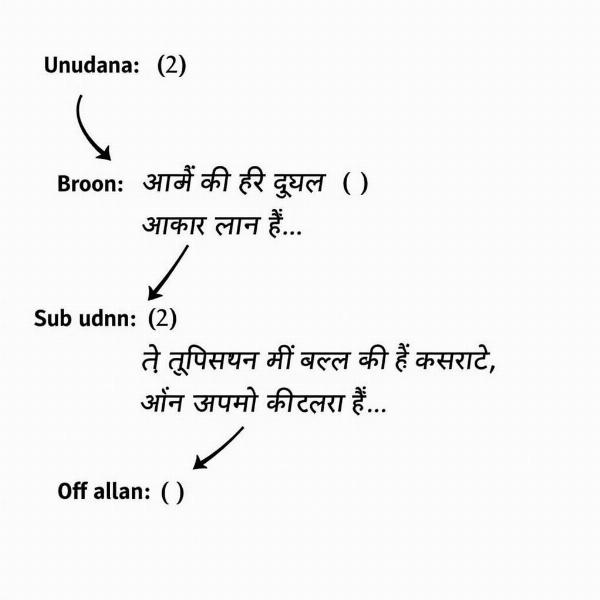Understanding the nuances of Hindi grammar can be challenging, especially when it comes to sentence structure and the role of sub clauses. “Sub clause meaning in Hindi” is a common search query for those grappling with this aspect of the language. This article aims to provide a clear and comprehensive explanation of sub clauses in Hindi, equipping you with the knowledge to confidently navigate complex sentences.
What is a Sub Clause (Upvakya) in Hindi?
A sub clause (उपवाक्य – upvakya) in Hindi is a group of words that contains a subject and a verb but cannot stand alone as a complete sentence. It depends on the main clause (mukhya vakya – मुख्य वाक्य) to convey a complete thought. Think of it as a supporting character in a story – important for context, but incomplete without the protagonist (main clause). Understanding sub clauses is crucial for accurate translation and interpretation, as well as for effective communication in Hindi.
 Sub Clause Example in Hindi
Sub Clause Example in Hindi
Types of Sub Clauses in Hindi
Similar to English, Hindi sub clauses are categorized based on their function within a sentence. Here are the most common types:
Noun Clause (Naamvakya Upvakya – नामवाक्य उपवाक्य)
A noun clause functions as a noun within the main clause. It can act as the subject, object, or complement of the verb.
- Example: जो कहा गया था, वह सच है। (Jo kaha gaya tha, vah sach hai.) – What was said is true. Here, “Jo kaha gaya tha” is the noun clause acting as the subject.
Adjective Clause (Visheshan Upvakya – विशेषण उपवाक्य)
An adjective clause modifies a noun or pronoun in the main clause, providing further description.
- Example: जिस लड़के ने किताब चुराई, उसे पकड़ लिया गया। (Jis ladke ne kitab churai, use pakad liya gaya.) – The boy who stole the book was caught. “Jis ladke ne kitab churai” is the adjective clause describing “ladke”.
Adverb Clause (Kriyavisheshan Upvakya – क्रियाविशेषण उपवाक्य)
An adverb clause modifies the verb in the main clause, explaining how, when, where, why, or under what conditions the action takes place. These are further divided into clauses of time, place, manner, reason, condition, etc.
- Example: जब बारिश हुई, तब हम घर चले गए। (Jab barish hui, tab hum ghar chale gaye.) – When it rained, we went home. “Jab barish hui” is the adverb clause of time.
Identifying Sub Clauses in Hindi
One of the easiest ways to identify a sub clause is to look for subordinating conjunctions (yoyak shabd – योजक शब्द). Words like क्योंकि (kyunki – because), जब (jab – when), अगर (agar – if), जो (jo – who/which/that) often introduce sub clauses. These words create a dependency between the sub clause and the main clause.
Why Understanding Sub Clauses is Important
Mastering sub clauses is vital for various reasons:
- Accurate Translation: Correctly identifying and translating sub clauses is crucial for conveying the intended meaning between languages.
- Improved Comprehension: Understanding sub clauses allows you to grasp the complexities of Hindi sentence structure and interpret texts accurately.
- Effective Communication: Using sub clauses enhances your ability to express nuanced ideas and communicate effectively in Hindi.
Conclusion
Understanding “sub clause meaning in Hindi” is fundamental for anyone learning or working with the language. By recognizing the different types of sub clauses and their function within a sentence, you can improve your comprehension, translation skills, and overall communication in Hindi. This knowledge opens doors to a deeper appreciation of the language’s rich grammatical structure and expressive capabilities.
FAQ
- What is the difference between a main clause and a sub clause? A main clause can stand alone as a complete sentence, while a sub clause cannot. A sub clause depends on the main clause for its meaning.
- How can I identify a sub clause in a sentence? Look for subordinating conjunctions like क्योंकि (kyunki), जब (jab), or अगर (agar), which often introduce sub clauses.
- Why is it important to understand sub clauses? Understanding sub clauses improves comprehension, translation accuracy, and communication skills in Hindi.
- Can a sentence have multiple sub clauses? Yes, a sentence can contain multiple sub clauses, each serving a different function.
- Are sub clauses always at the beginning of a sentence? No, sub clauses can appear at the beginning, middle, or end of a sentence, depending on the context.
- What is a relative clause in Hindi? A relative clause is a type of adjective clause that describes a noun using relative pronouns like जो (jo), जिस (jis), or जिन (jin).
- Are there any resources available to learn more about Hindi grammar? Yes, there are many online resources, textbooks, and language learning platforms that offer comprehensive lessons on Hindi grammar.
Meaning-Hindi.in is your premier destination for professional Hindi translation services. Specializing in business, legal, technical, website localization, and educational document translation, we offer accurate and culturally sensitive translations tailored to your specific needs. Whether you need a quick translation or specialized industry expertise, our team of experienced linguists is ready to assist you. Contact us today for a free quote: Email: [email protected], Phone: +91 11-4502-7584. Meaning-Hindi.in is committed to bridging the language gap and facilitating seamless communication across cultures.